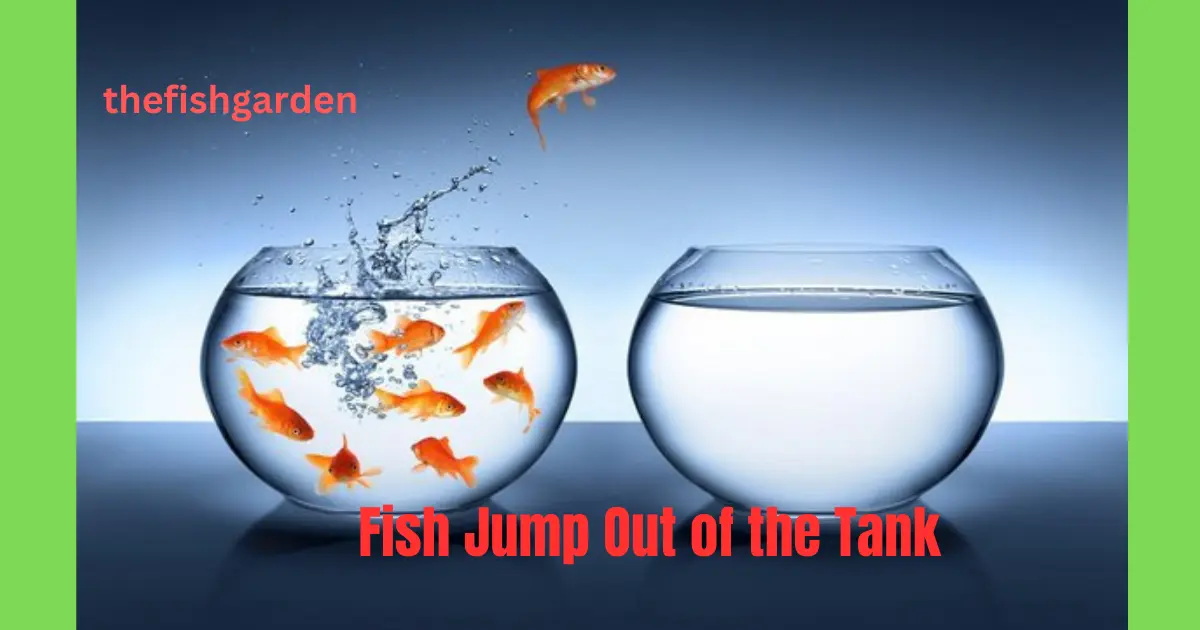It can be alarming to see your pet fish jumping out of its tank. This behavior is known as “jumping” or “leaping,” and there are several possible reasons why fish exhibit this behavior. Some causes are benign, while others can indicate underlying health issues or environmental problems that need to be addressed.
In this comprehensive article, we will explore the key reasons fish jump from their tanks, warning signs to look out for, ways to prevent jumping, and what to do if you find your fish outside its tank. Read on to learn why fish leap and how to protect your aquatic pets.
What Causes Fish to Jump from Their Tank?
There are several possible triggers that can cause fish to jump or leap out of their aquarium. Here are some of the most common reasons fish exhibit this behavior:
Poor Water Quality
One of the most frequent causes of jumping is poor water conditions. When levels of ammonia, nitrites, or nitrates rise too high, or oxygen levels fall too low, it creates an unhealthy environment for fish. They will try to escape these adverse water conditions by leaping from the tank.
High ammonia is especially dangerous, as it burns the gills and skin of fish. Nitrites prevent proper oxygen uptake, and nitrates accumulate over time to reach toxic levels. Test your aquarium water frequently and perform partial water changes as needed to keep pollutants under control.
Aggression from Tankmates
Aggressive bullying from other tankmates can also lead to jumping. Certain types of fish are prone to nipping, chasing, and intimidating fish tankmates. This harassment causes stress that makes fish want to flee the tank.
Target fish that are jumped by aggressors include ones with long, flowing fins like guppies, bettas, and angelfish. Avoid pairing aggressive species like tiger barbs, cichlids, or Oscar fish with more docile varieties. Overcrowding tanks also tends to increase aggression.
Parasites
Parasites like ich, flukes, and anchor worms can infest aquarium fish and irritate their skin. The parasites make fish rub and scrape against surfaces and leap in an attempt to detach the offenders. Treating the whole tank to eliminate the parasite source brings relief.
Disease
Bacterial, viral, or fungal infections can affect the skin, gills, and fins of fish in ways that make them jump. For example, columnaris disease can damage gill tissues and compromise respiration. Jumping is a reflexive response as fish try to escape the discomfort and breathe easier.
Improper Tank Conditions
Various issues with the tank setup can contribute to jumping. For example, water that is too hot or too cold stresses fish. Inadequate tank lighting or lack of places to hide also creates an unsafe habitat. Fish jump to get away from undesirable conditions.
Reaction to Frightening Stimuli
Sudden loud noises, banging on the tank, or proximity to large moving objects outside the tank can startle fish and make them jump. Make sure the tank is in a quiet, low-traffic area of the home to minimize external stimuli.
Hunting for Food
Healthy fish eager for a meal will often leap out of the water when they see owners approaching with food. Only feed your fish at designated mealtimes rather than sporadically throughout the day to curb this food-seeking behavior.
Pursuing Prey
Predatory fish may jump to catch live foods offered in the tank. For example, Oscar fish are known to leap from the water to grab mice, crickets, and other prey. While hunting enrichment is good, only offer live foods under close supervision.
Boredom
Fish kept in small, barren tanks with little enrichment may jump simply due to boredom and curiosity about what lies outside their habitat. Make sure your tank has plenty of plants, rocks, driftwood, and other decor for engaging and stimulating fish.
Exploration
Some fish, especially young ones, leap out of an instinctual need to explore beyond their immediate environment. Providing an adequately sized tank setup filled with enriching accessories and tankmates can help curb this urge to venture elsewhere.
Warning Signs Your Fish Might Jump
Certain behaviors can indicate that your fish may be getting ready to jump from the tank or are showing signs of distress that could lead to jumping. Here are some warning signs:
- Rubbing against decor
- Swimming near the water surface
- Swimming erratically
- Gasping for air
- Scrapping against the substrate
- Lethargic movement
- Loss of appetite
- Hiding more than usual
- Clamped fins
- Whitish gills or patches on skin
- Reddened areas on skin, fins, or gills
Take these behaviors seriously and investigate potential causes. Address any husbandry issues, treat parasites or infections, and reduce stressors to prevent your fish from jumping.
How to Prevent Fish from Jumping Out

With some adjustments to your tank setup and fishkeeping practices, you can greatly reduce the likelihood of fish jumping. Here are some tips:
- Get an adequately sized tank – Larger tanks dissipate pollutants like ammonia and also allow territorial or active fish more room to roam. Avoid cramming too many fish in a small space.
- Use a tight-fitting lid or hood – A secure lid blocks fish from leaping out while still allowing for air and gas exchange. Avoid large gaps where crafty jumpers can escape.
- Keep water parameters optimal – Test and change the water as needed to remove harmful waste chemicals that irritate fish. Provide proper temperature, pH, and hardness levels for your species.
- Reduce tankmate aggression – Avoid combining aggressive species that may intimidate shy fish. Remove bullies and add places for fish to hide and occupy separate territories.
- Offer enrichments – Provide plants, rocks, driftwood, substrate, and tankmates to engage curious fish with exploration and natural behaviors. A well-decorated tank helps prevent boredom.
- Establish fixed feeding times – Feeding fish at the same times each day prevents food-seeking behavior. Use slow-sinking foods that are less likely to trigger frenzied leaping.
- Dim tank lights at night – Lower light levels after dark help create a calm environment and reduce nighttime jumping. Make day/night light cycles match natural rhythms.
- Perform parasite treatments – Eliminate any parasites that could be irritating fish and triggering rubbing, flashing, and jumping. Quarantine new fish to prevent introducing pathogens.
- Avoid overstocking – Limit the number of fish to prevent aggressive behavior and maintain high water quality. Follow general stocking density guidelines for your tank size and species.
What to Do if Your Fish Jumps Out of the Tank
Even with preventive measures, you may sometimes encounter a fish that has leapt from its tank. Time is of the essence for the stranded fish’s survival, so act quickly if this happens using these steps:
1. Scoop Up the Fish
Gently and quickly scoop up the jumped fish in a small net and return it to the tank. Avoid grabbing fish with dry hands, as this can damage their protective slime coating. Never place jumped fish back in the tank by hand.
2. Assess the Fish’s Condition
Check the fish for any signs of injury like cuts, abrasions, or scratches. Also look for rapid gilling motions or disoriented swimming that may indicate respiratory distress. Loss of scales after drying out is also common.
3. Acclimate the Fish Slowly
Prior to release, float the net holding the fish in the tank for 15 minutes so the fish can readjust to the water temperature. This prevents shock from sudden temperature changes.
4. Treat Any Injuries
Use antibiotic treatments like salts, methylene blue, or antifungal remedies to prevent infection of wounds. Move injured fish to a quarantine tank for close monitoring during recovery.
5. Reduce Tank Stressors
After placing the fish back in the main tank, assess environmental conditions and make adjustments to reduce stressors or aggression that may have caused the jumping.
6. Offer Supportive Care
Provide optimal water quality and nutrition support jumping fish as they recover from injuries and reacclimate to the tank environment. Delay water changes temporarily.
7. Watch for Secondary Infections
Monitor for signs of secondary bacterial or fungal infections in the days following a jumping event. Treat promptly with medications if wounds become infected.
8. Separate Chronic Jumpers
Individual fish that jump repeatedly may need temporary isolation in a quarantine tank with a secured lid until their trigger for jumping behavior can be determined.
With quick action, most jumped fish can recover and thrive again in their home aquarium. Prevention is always preferable, but even chronic jumpers can often be cured by addressing the underlying causes of stress and implementing proper husbandry techniques.
5 FAQs About Fish Jumping from Tanks
New fishkeepers often have many questions about the alarming experience of seeing their fish leaping out of the tank. Here are answers to 5 frequently asked questions:
Can jumping hurt or kill my fish?
Yes, jumping can certainly injure or even kill a fish in some cases. The fall to the floor along with subsequent lack of water can lead to physical trauma, suffocation, and dangerous drying out of the skin and gills. Time out of water and the resulting stress can be fatal if the fish is not recovered promptly.
Are certain fish species more prone to jumping?
Some species are notorious jumpers, including bettas, gobies, dragonfish, cichlids, and archerfish. Active schooling fish like tetras and barbs may also jump frequently. But any fish can potentially jump if its environment stresses it enough.
Is a jumping fish a sign of illness?
Not always, but it can be. Jumping may indicate underlying health issues like parasites, infections, or gill problems. But jumping is more commonly caused by environmental stressors like poor water quality, aggression, or lack of habitat enrichment.
Should I let jumped fish back into the main tank right away?
No, never immediately put a jumped fish back into the original tank. First isolate, acclimate, and monitor the fish in quarantine to prevent introducing pathogens to the main tank inhabitants. Watch for signs of secondary health issues after jumping.
What tank modifications prevent jumping?
Making sure all tank openings are securely covered, providing good water parameters, reducing aggression, offering enrichment, and maintaining appropriate population density can all help curb jumping urges. Getting a larger tank is also beneficial.
Conclusion
Fish that leap out of their tanks can be a startling and troubling sight for aquarium owners. While jumping is not entirely preventable, understanding its underlying causes and taking proactive measures can significantly reduce incidents. By maintaining optimal tank conditions, reducing stress and aggression, adding enrichments, and making simple tank adjustments, most fish can thrive without feeling the need to venture beyond their aquatic habitat.
Be vigilant for warning signs preceding jumping and act promptly should a fish become stranded outside its enclosure. With attentive fishkeeping and emergency care, even chronic jumpers often resume normal behavior once their stress triggers are addressed. A well-designed tank setup and healthy environment keep pet fish content in their home aquarium.
Table of Contents
- Overview
- What Causes Fish to Jump from Their Tank?
- Poor Water Quality
- Aggression from Tankmates
- Parasites
- Disease
- Improper Tank Conditions
- Reaction to Frightening Stimuli
- Hunting for Food
- Pursuing Prey
- Boredom
- Exploration
- Warning Signs Your Fish Might Jump
- How to Prevent Fish from Jumping Out
- What to Do if Your Fish Jumps Out of the Tank
- 5 FAQs About Fish Jumping from Tanks
- Conclusion
